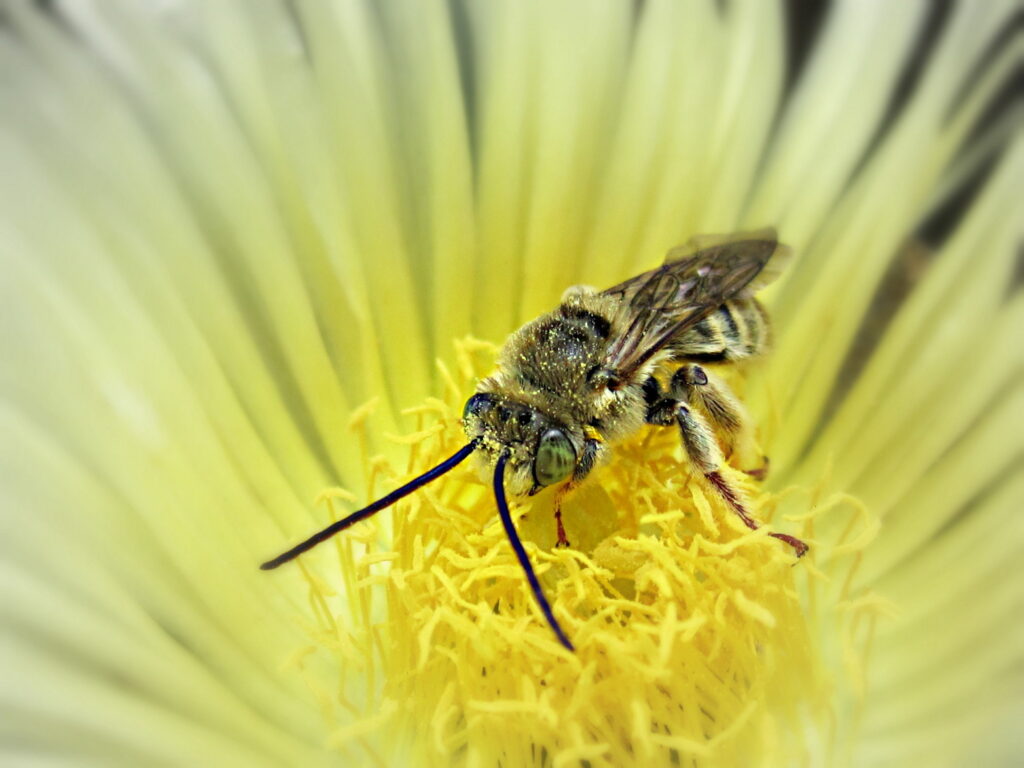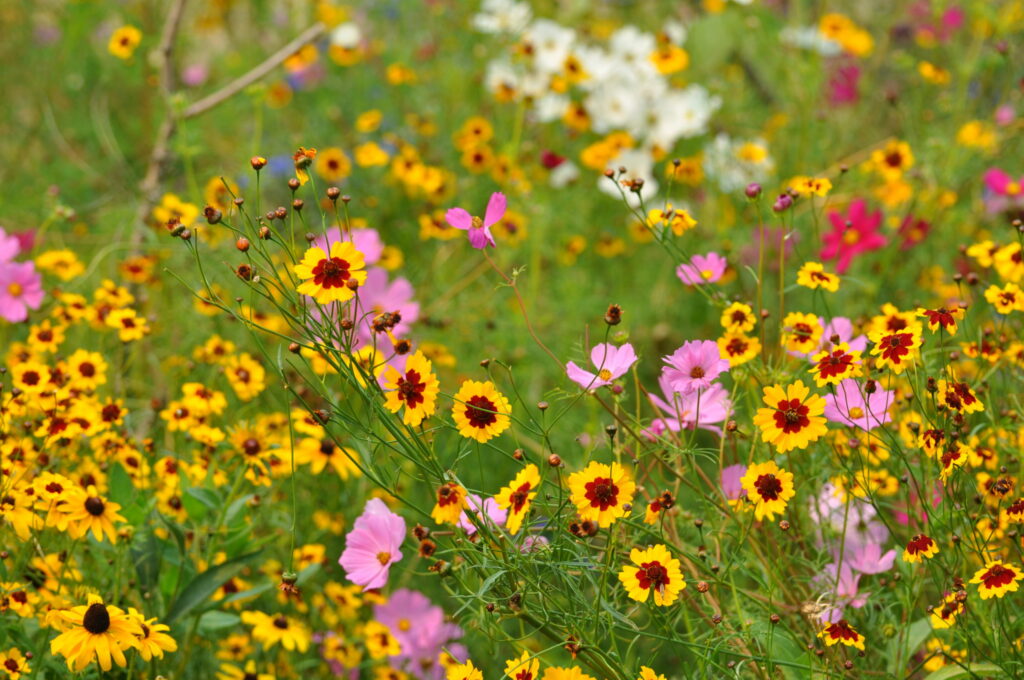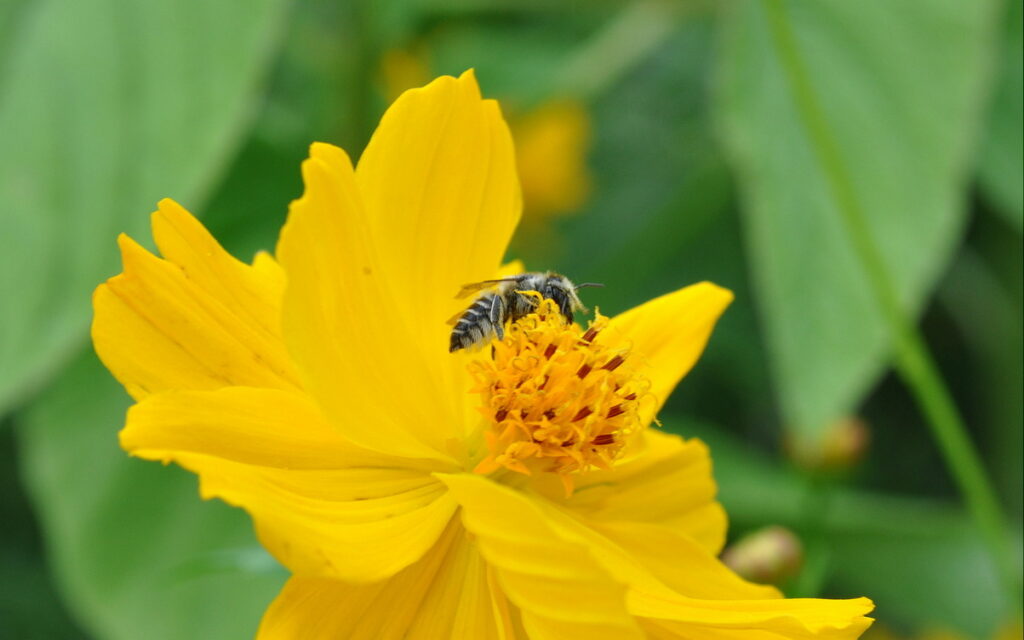By Sharon Selvaggio, Pesticide Program Specialist, The Xerces Society
In your Bee City USA or Bee Campus USA community, protecting and expanding habitat for pollinators has become a community priority. That means that we can all take part in this promising work.
What is your role? Perhaps you are not quite sure what pollinators do and why we all depend on them? If that’s the case, we invite you to simply learn a bit more about how pollinators facilitate plant reproduction. Did you know 85% of flowering plants require an animal to help them produce seed? For example, that apple in your lunch is really just a juicy container for seeds. The apple is only there because some pollinator—probably a bee—visited a flower, and while busy gathering food for its own offspring, transferred pollen to the flower pistil, allowing fertilization that culminated in a fruit with seeds. The juicy container attracts foragers (like us) who then disperse the seed. Fruits and seeds are also important food for familiar backyard wildlife, like birds. So pollinators are truly a linchpin in the food system of the planet.
Maybe you understand the importance of pollinators but are uncertain about your connection to pollinator needs? After all, you might think, they survived this long – can I really make a difference? Yes, you can!

Just in North America, nearly a third of bumble bee species and almost a fifth of butterfly species are at risk of extinction. Key threats that pollinators face from human-derived causes include exposure to pesticides, loss of habitat, and climate change. Fortunately, even small steps can make meaningful contributions to pollinator conservation—and everyone can play a role in reversing these threats. As a community member in a Bee City or Bee Campus, we invite you to consider one small action this year to offset these threats and make life just a bit better for the bees we depend on.

For example, did you know that an estimated 200 million pounds of pesticides are used each year in American towns and cities? Many pesticides are even hidden inside fertilizer products. The cumulative effect of all these chemicals is really an unknown because there is no government agency that can or will test the myriad chemical combinations so blithely applied across the landscape. Still, we know enough about the toxic effects of hundreds of insecticides, fungicides, and yes—even herbicides—to recognize that applications in our yards are a big risk for our backyard pollinators.
You can do your part to expand healthy habitat for pollinators by eliminating insecticides, fungicides, and herbicides applied to your property (if you have it). Certainly you should avoid any direct applications to flowering plants (don’t forget that non-coniferous trees flower too!). But even pesticides applied to non-flowering plants can be picked up by bees. The safest way to protect pollinators in your own yard is to avoid use of all pesticides. Alternatives like spreading mulch to prevent weeds, or handpicking any problematic insects can be effective and doable in a typical residential lot.

Habitat loss can be offset if you have space to offer plants. For example, consider planting flowers that attract bees or leaving a bit of bare soil so that native bees have a place to nest (most nest in the ground and require patches of bare soil).
You can take action to reverse the threats of pesticides and habitat loss right in your yard, but to work on the threat of climate change, think more broadly about your daily habits. Climate change is caused by the burning of fossil fuels. To help out here, consider walking or biking instead of driving, using just a little less heat or air conditioning, reusing items rather than purchasing new ones, or drying your clothes on the line.
Providing a safe home for pollinators can be deeply satisfying. If you’re already doing these things, there’s one more thing you can add. Take the Pollinator Pledge! This comes with a commitment to help others understand and be inspired by your landscape philosophy—and helps your Bee City or Bee Campus really bear fruit—just like a pollinated plant!
Resources:
Bee City USA® and Bee Campus USA work to galvanize communities to sustain pollinators, in particular the more than 3,600 species of native bees in this country, by increasing the abundance of native plants, providing nest sites, and reducing the use of pesticides. Bee City USA and Bee Campus USA are initiatives of the Xerces Society for Invertebrate Conservation. Find out more at beecityusa.org.
Alternatives to Pesticides. Need some assistance to learn effective ways to manage your landscape without the use of chemicals? Consult this fact sheet for a quick overview: https://xerces.org/publications/fact-sheets/smarter-pest-management-protecting-pollinators-at-home. For a deeper dive, browse through the many resources available here: https://xerces.org/pesticides/pesticides-your-garden
Plants attractive to Pollinators: Recommendations for highly attractive pollinator plants for our area can be reviewed at the Xerces Society Pollinator Conservation Resource Center https://www.xerces.org/pollinator-resource-center.
Pollinator Pledge: https://www.xerces.org/pollinator-conservation/pollinator-protection-pledgePollinator Habitat Sign: This beautiful sign will help others see that your garden is more than just a pretty spot – it’s a home for pollinators! https://gifts.xerces.org/products/pollinator-habitat-sign-2020





